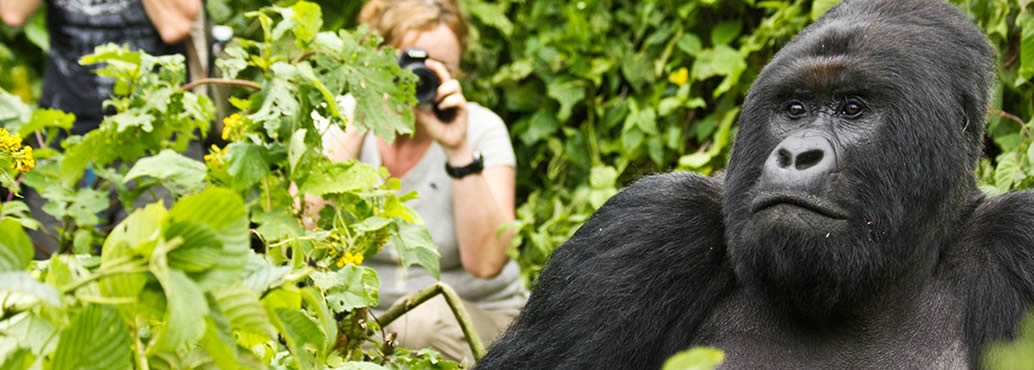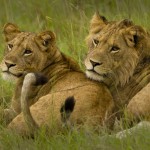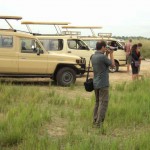
A trekking safari to Africa seeking to visit mountain gorillas offers one of the most rewarding wildlife adventures for a modern traveller. Mountain gorillas look just like man and watching them in the jungle offers a very special and emotional experience that offers every tourist a special memory.
Surviving in only 3 countries in central and Eastern Africa – Uganda, Rwanda and Democratic Republic of Congo, mountain gorilla population was threatened to near extinction in the past 2 decades to the extent that, they were less than 350 species left and would be extinct if not for Dain Fossey who dedicated the life to protecting gorillas in the jungle. Vigorous conservation campaigns were launched which saw significance increase in their number to about 900 individuals according to the 2012 census.
Uganda shelters half of the total populations of mountain gorillas with two national parks where tourists can go visit habituated gorilla groups in Mgahinga national park and Bwindi forest. The rest of the gorilla population is located in Congo’s Virunga National park and Rwanda’s Volcanoes National park. Of the 36 estimated gorilla families in Uganda, only 13 of them are habituated and 12 of which are used for tourism while one is intended for research. Of the 12 Gorilla families meant for tourism, 11 are in Bwindi National park and 1 roams in Mgahinga National park but sometimes crosses into Congo and Rwanda though it has been recently seen to settle on the Ugandan side f Mgahinga.
Planning a Uganda gorilla safari requires tourists to book a gorilla permit for a day you plan to visit in advance as the demand for them is high and may get finished before the tracking date. Permits can be obtained from Uganda Wildlife Authority offices or your tour operator can help you get it at the same price as he organizes you the whole package.
What to expect the day of gorilla trekking
Early in the morning, your tour guide will pick you from the lodge to the park head quarters (starting point for tracking) for briefing about the dos and don’ts while with the gorillas. You are expected to come with drinking water, energy giving snacks, tracking gear and packed lunch which sometimes may be provided by your lodge depending on how your tour operator negotiated with them.
Tracking then commences thereafter as you head into the thick jungles with rugged terrain. You will walk through narrow paths and sometimes the guide has to create way by cutting some of the shrubs in your way. The tracking activity is strenuous and requires a relative degree of fitness as you will hike some slopes and pass through swampy areas.
When you finally catch up with the gorillas, you are guaranteed one full hour with them as you watch them play, communicate and nurse each other in their natural setting. You are free to take photos to show your people when you go back home.
As you track for mountain gorillas in the jungle, you are not constrained to see other wildlife since this forest is a habitat for a variety of wildlife (over 350 bird and 120 mammal species). You may as well catch a sight of other 9 primates including baboons, chimpanzees and a variety of monkey species. With this enchanting exercise, you will find the worth of your dollars.
Gorilla tracking Rules
While you plan for gorilla tracking, its advisable to consider the guidelines/ code of conduct so as to have an ultimate experience. The tracking rules and procedures are uniform throughout the 3 countries since the gorilla range cuts across territories and roam freely across borders.
A maximum number of 8 visitors is allowed to visit a group of habituated mountain gorillas in a day. This minimizes social disturbance and stress to the gorillas and the risk of their exposure to human-borne diseases. Below is a set of guidelines to help you be ready.
- Please always keep your voices low in order not to scare them away or irritate them. Noise may also hinder you from tracing their position in the forest if you do not pay attention to hear their vocal communications. You will also be able to observe the great bird life and other wildlife in the forest.
- DO NOT leave any litter in the park. Whatever you bring into the forest should be carried back with you to avoid degrading the gorilla’s habitat and also the resultant diseases from such pollutants.
- When you approach the mountain gorillas, you are advised to keep a distance not closer than 7 meters for your own good and the health of the mountain gorilla. You are guaranteed 1 hour to see, observe and take photos and even ask your guide all you need to know about the gorilla.
- You must stay in tight group when you are near the gorillas and follow your guide’s instruction.
- Smoking, drinking or eating when you are near the gorillas is prohibited. Eating or drinking inevitably will increase the risk of food/drink morsels/droplets falling, which could increase the risk of transmission of diseases.
- If the gorillas charge (attempt to attack), follow the guide’s example (crouch down slowly, do not look the gorillas directly in the eyes and wait for the animals to pass). Do not attempt to run away because that will increase the risk.
- Flash photography is highly forbidden. When taking pictures move slowly and carefully and make sure your camera is not producing any sound or flash.
- Do not touch the gorillas because they are wild animals and therefore unpredictable. They can do anything at any time.
- After the visit keep your voices down until you are 200 meters away from the gorillas.
- If you are feeling ill, or you have a contagious disease like flue, volunteer to stay behind. An alternate visit will be arranged for you, or you will be refunded your money. This is because the gorillas can be infected by any human disease and treating them is costly
- If you feel the urge to cough or sneeze when you are near the gorillas, please turn your head away and cover your nose and mouth in order to minimize the spread of bacteria or virus.
- If you need to go to the toilet while in the forest, please ask the guide to dig you a hole with his panga / hoe. Make sure the hole is 30 cm deep and cover it when you finish.

 Posted in
Posted in 

